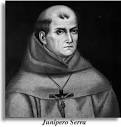 Current Event During Pope Francis’ visit to the United States of America last week, he canonized Father Junipero Serra. This means that he proclaimed Father Serra a saint. For most Americans, this brings up many questions. What is a saint? Who was Father Serra? Why is there a controversy surrounding Father Serra? What does Father Serra have to do with American history? To understand American history it is necessary to understand Father Serra. A Quick History of Sainthood In Roman Catholic and Orthodox Churches, someone who lives in Christ and is believed in Heaven is considered a saint. But those believed worthy of greater honor or emulation are proclaimed a saint. This practice began immediately after the crucifixion of Christ. In the first centuries, early Christian spread the word of Christ by speaking to others. The Roman Empire persecuted Christians, martyring many. A martyr is someone who died for his faith. Early Christians began referring to those martyred as saints. For example, all early Christians referred to the Apostles as saints, such as Saint Peter, who Christians believe to have been crucified upside down. The first person to have been officially declared a saint was in 993, when Pope John XV proclaimed Bishop Ulrich of Augsburg a saint, along with Polish martyrs. In 1234, the Catholic Church adopted a formal canonization process. Who Was Father Serra? Last week, Father Serra became the United States’ first Hispanic saint. He lived in 18th century Spain and became a priest. Father Serra joined the Franciscans, a medieval religious order, and promised a life of poverty. For many years, Father Serra’s life consisted of prayer, singing, physical labor, spiritual readings and instruction. Serra became a professor, and was known for being a great teacher. Giving up a comfortable life at the university, Serra volunteered to go to the new land to establish missions in California. Father Serra established the first nine of 21 missions in California, which stretch from San Diego to Sonoma. Serra Christianized thousands of Indians, and the Spanish taught them how to farm, raise livestock, make soap, weave clothes, and how to survive in the new Spanish economy. Until about thirty years ago, no one questioned the accomplishments of Father Serra. Some think Serra’s accomplishments were actually tragedies for the native peoples of California and that Serra should not be honored. Serra and the Spanish carried diseases the Indians did not have, and because of the Europeans, historians think 90% of the Indians died. Some even claim this is proof of genocide. Also, once the Indians joined a mission, they were never allowed to leave. The missionaries used the military to force Indians to stay. Some argue that the Indians were physically punished for not following the rules, but, Spanish were also physically punished for the same reasons. There are many reasons these arguments against Serra are not strong. One, the Spanish did not know they carried diseases that would hurt the Indians. The word genocide means when a country as a policy tries to murder a people. There was no Spanish policy of genocide. Also, no Indian was forced to convert to Christianity and become part of the mission, and, there is no evidence Serra ever hurt an Indian. In Europe in the 1700s, serfs were not allowed to leave the land they worked on. The Spanish mentality of the 1700s was the same as every European in the medieval ages. Because of this, any Indian who ran away from the mission, was forced back by the Spanish soldiers. This was not a policy of Father Serra, but it was Spanish law. American History and Father Serra Father Serra is important for the history of California and also for the United States of America. During the American Revolution, a group of untrained farmers fought and beat the strongest army and navy in the world. Their military leader was George Washington, and he led the Continental Army in beating the British and establishing the United States of America. In 1777, Father Serra had all of the California missions collect money and he sent $137 to General Washington. Every state chooses two people from their state to honor by placing their statue in the U.S. Capitol. Since, Father Serra’s statue is one of two from California that are located at the U.S. Capitol (the other is Ronald Reagan). He has been traditionally recognized as one of California’s most important citizens. On his visit to America, Pope Francis visited this statue and said of Serra, “tragically, the rights of those who were here long before us were not always respected.” He said that relations between European and natives “were often turbulent and violent,” but “it is difficult to judge the past by the criteria of the present.” Questions 1. Who was Father Serra? 2. What did Pope Francis do regarding Father Serra las week? 3. What is the controversy surrounding Father Serra based on? 4. How is Father Serra tied to California and American history? 5. What is your opinion of Father Serra? Was he a great man? Was he an oppressor of Indians?
0 Comments
Leave a Reply. |
John De GreeJohn De Gree writes the current events with a look at the history of each topic. Articles are written for the young person, aged 10-18, and Mr. De Gree carefully writes so that all readers can understand the event. The perspective the current events are written in is Judeo-Christian. Receive Articles and Coupons in Your EmailSign Up Now
For Email Marketing you can trust. Archives
June 2024
Categories
All
|
|
SUPPORT
|
RESOURCES
|
|


 RSS Feed
RSS Feed



